牛津译林版九年级上册Unit 2 Colour单元主题拓展阅读课件(共22张PPT)
文档属性
| 名称 | 牛津译林版九年级上册Unit 2 Colour单元主题拓展阅读课件(共22张PPT) |  | |
| 格式 | pptx | ||
| 文件大小 | 336.1MB | ||
| 资源类型 | 教案 | ||
| 版本资源 | 牛津译林版 | ||
| 科目 | 英语 | ||
| 更新时间 | 2022-10-07 13:16:16 | ||
图片预览


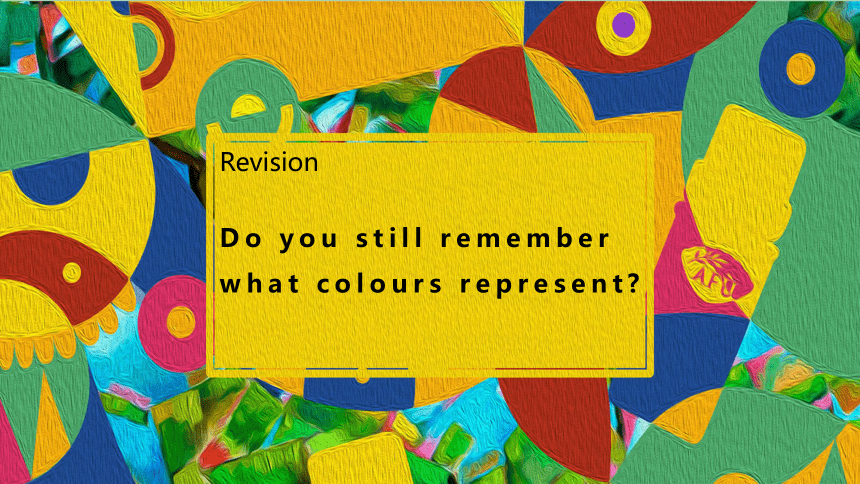
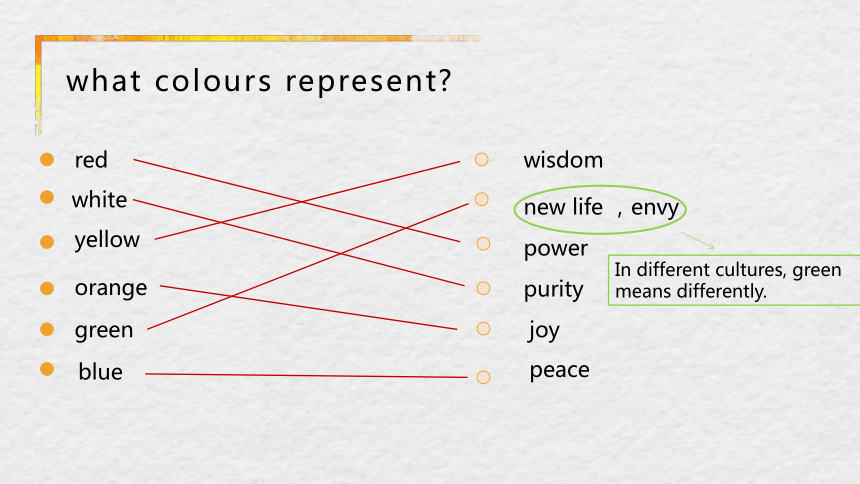
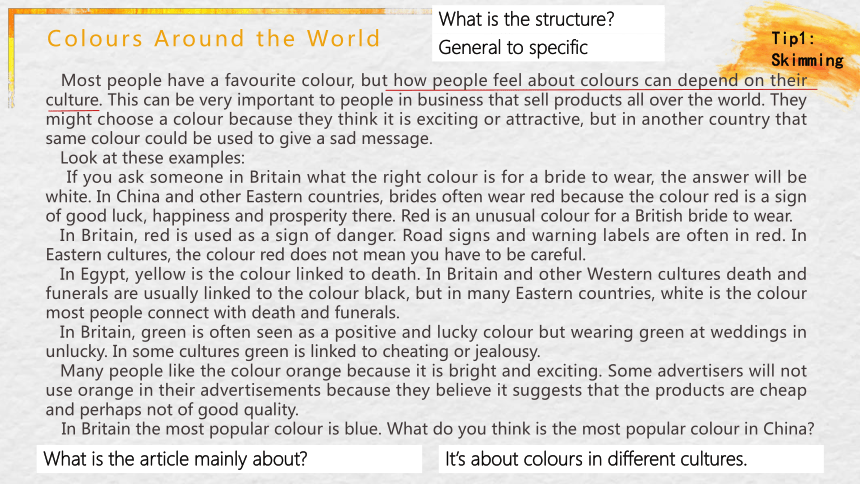
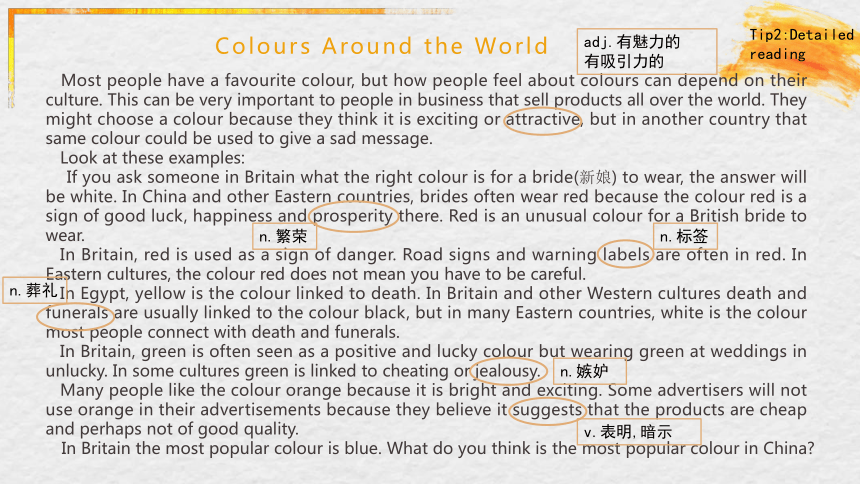

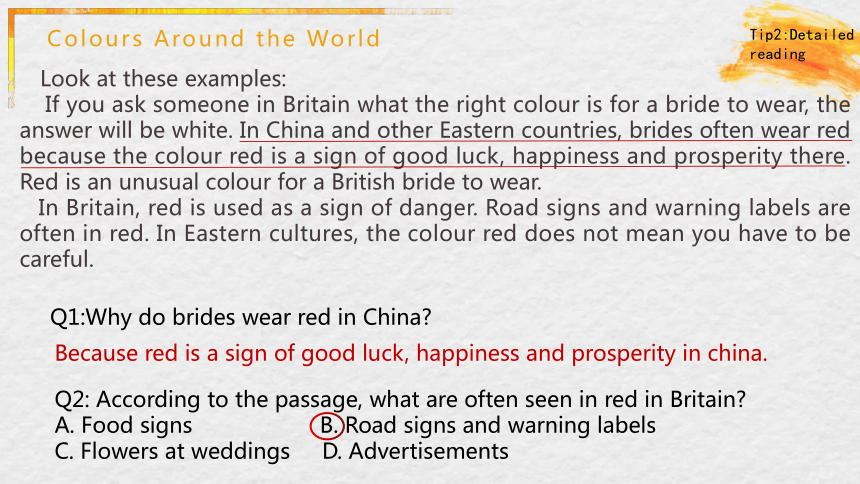

文档简介
COLOURS
Extended Reading
9A Unit2
Do you still remember
what colours represent?
Revision
what colours represent?
red
white
yellow
orange
green
blue
wisdom
new life ,envy
peace
power
purity
joy
In different cultures, green means differently.
Colours Around the World
Most people have a favourite colour, but how people feel about colours can depend on their culture. This can be very important to people in business that sell products all over the world. They might choose a colour because they think it is exciting or attractive, but in another country that same colour could be used to give a sad message. Look at these examples:
If you ask someone in Britain what the right colour is for a bride to wear, the answer will be white. In China and other Eastern countries, brides often wear red because the colour red is a sign of good luck, happiness and prosperity there. Red is an unusual colour for a British bride to wear. In Britain, red is used as a sign of danger. Road signs and warning labels are often in red. In Eastern cultures, the colour red does not mean you have to be careful. In Egypt, yellow is the colour linked to death. In Britain and other Western cultures death and funerals are usually linked to the colour black, but in many Eastern countries, white is the colour most people connect with death and funerals. In Britain, green is often seen as a positive and lucky colour but wearing green at weddings in unlucky. In some cultures green is linked to cheating or jealousy. Many people like the colour orange because it is bright and exciting. Some advertisers will not use orange in their advertisements because they believe it suggests that the products are cheap and perhaps not of good quality. In Britain the most popular colour is blue. What do you think is the most popular colour in China?
What is the structure?
General to specific
Tip1:
Skimming
What is the article mainly about?
It’s about colours in different cultures.
Colours Around the World
Most people have a favourite colour, but how people feel about colours can depend on their culture. This can be very important to people in business that sell products all over the world. They might choose a colour because they think it is exciting or attractive, but in another country that same colour could be used to give a sad message. Look at these examples:
If you ask someone in Britain what the right colour is for a bride(新娘) to wear, the answer will be white. In China and other Eastern countries, brides often wear red because the colour red is a sign of good luck, happiness and prosperity there. Red is an unusual colour for a British bride to wear. In Britain, red is used as a sign of danger. Road signs and warning labels are often in red. In Eastern cultures, the colour red does not mean you have to be careful. In Egypt, yellow is the colour linked to death. In Britain and other Western cultures death and funerals are usually linked to the colour black, but in many Eastern countries, white is the colour most people connect with death and funerals. In Britain, green is often seen as a positive and lucky colour but wearing green at weddings in unlucky. In some cultures green is linked to cheating or jealousy. Many people like the colour orange because it is bright and exciting. Some advertisers will not use orange in their advertisements because they believe it suggests that the products are cheap and perhaps not of good quality. In Britain the most popular colour is blue. What do you think is the most popular colour in China?
adj.有魅力的
有吸引力的
n.繁荣
n.标签
n.葬礼
n.嫉妒
v.表明,暗示
Tip2:Detailed reading
Colours Around the World
Most people have a favourite colour, but how people feel about colours can depend on their culture. This can be very important to people in business that sell products all over the world. They might choose a colour because they think it is exciting or attractive, but in another country that same colour could be used to give a sad message.
Tip2:Detailed reading
Q:Why is it important for people in business to choose colours?
Because colours in different countries have different meanings which might make a great difference to their business.
Colours Around the World
Look at these examples:
If you ask someone in Britain what the right colour is for a bride to wear, the answer will be white. In China and other Eastern countries, brides often wear red because the colour red is a sign of good luck, happiness and prosperity there. Red is an unusual colour for a British bride to wear. In Britain, red is used as a sign of danger. Road signs and warning labels are often in red. In Eastern cultures, the colour red does not mean you have to be careful.
Q1:Why do brides wear red in China?
Because red is a sign of good luck, happiness and prosperity in china.
Tip2:Detailed reading
Q2: According to the passage, what are often seen in red in Britain?
A. Food signs B. Road signs and warning labels
C. Flowers at weddings D. Advertisements
Colours Around the World
Tip2:Detailed reading
In Egypt, yellow is the colour linked to death. In Britain and other Western countries death and funerals are usually linked to the colour black, but in many Eastern countries, white is the colour most people connect with death and funerals. In Britain, green is often seen as a positive and lucky colour but wearing green at weddings in unlucky. In some cultures green is linked to cheating or jealousy. Many people like the colour orange because it is bright and exciting. Some advertisers will not use orange in their advertisements because they believe it suggests that the products are cheap and perhaps not of good quality.
death
in ________
yellow
in Eastern countries
_______
in ________ and other Western countries
_______
Egypt
white
Britain
black
Colours Around the World
Tip2:Detailed reading
In Egypt, yellow is the colour linked to death. In Britain and other Western countries death and funerals are usually linked to the colour black, but in many Eastern countries, white is the colour most people connect with death and funerals. In Britain, green is often seen as a positive and lucky colour but wearing green at weddings in unlucky. In some cultures green is linked to cheating or jealousy. Many people like the colour orange because it is bright and exciting. Some advertisers will not use orange in their advertisements because they believe it suggests that the products are cheap and perhaps not of good quality.
Q1: If you are a bride , will you choose to wear green at your wedding? Why?
No, I won’t. Because it is linked to cheating or jealousy.
Q2: Why do some advertisers avoid using organe in their advertisement?
A. Because orange is too bright.
B. Because orange represents jealousy.
C. Because they think orange suggests poor quality.
D. Because few people like this colour.
Tip3:Further
thinking
Colours Around the World
In ___________
White for a bride
Red for warning
____________ for death
Green as a positive and _____________ colour
In China and some other countries
_____________ for a bride
white or yellow for death
Green for ___________ or jealousy
Britain
Black
lucky
Red
cheating
What’s the purpose of the article? Why does the writer mention these differences?
The writer wants us to u___________(理解) the culture differences and not l_________(嘲笑)at others.
We should do as the R__________ do(入乡随俗)when we are abroad.
We should also d____________(发展) fine Chinese culture.
nderstand
augh
omans
evelop
The world around us is colourful, but not everyone’s world is full of colours. They can’t see clear colours and even there is only grey in their world.
Know About
Colour-blindness
Know About Colour-blindness
Colour-blindness, also known as a colour vision problem, is the inability to see the difference between some colours, especially red and green. Most common types of colour-blindness are genetic, meaning they are passed down from parents. People can also have colour-blindness later in life due to age, disease or injuries. We see colours thanks to the special cells at the back of our eyes. These cells are colour detectors. They are called cones. The cones in our eyes detect colours when lighting conditions are bright enough. There are three types of cones, with each one sensing red, green or blue light. Red, green and blue are the primary colours of light! So with just the three types of cones, you can see all the colours of the rainbow. Someone is colour-blind because some of their cones don’t work or are missing. They can still see colours, but they might have a hard time telling blue from purple, or red from green. Colour-blindness is fairly common. And men are much more likely to be colour-blind than women. There is no cure for colour-blindness that’s passed down in families, but most people find ways to adjust to it. Children with colour-blindness may need help with some classroom activities, and adults with colour-blindness may not be able to do certain jobs, like being a pilot or graphic designer. Keep in mind that most of the time, colour-blindness doesn’t cause serious problems. What about animals? Animals often see different colours from humans. Some see more. Some see fewer. Dogs and cats have only two cones and don’t see many colours. Bird eyes, on the other hand, have four kinds of cones. So they see colours we can’t even imagine!
Where can we read this article?
A.Education B.Sports C.Fashion D.Science
n.视觉
n.无能力
adj.基因的
n.伤害
n.检测器
n.锥形体
adv.
相当地
v.适应
n.飞行员
adj.绘画的
Know About Colour-blindness
Colour-blindness, also known as a colour vision problem, is the inability to see the difference between some colours, especially red and green. Most common types of colour-blindness are genetic, meaning they’re passed down from parents. People can also have colour-blindness later in life due to age, disease or injuries.
Q1. What are most common types of colour-blindness caused by?
A.Disease B. Age. C. Genes D. Injuries
the _________________ of colour-blindness
description
Know About Colour-blindness
We see colours thanks to the special cells at the back of our eyes. These cells are colour detectors. They are called cones. The cones in our eyes detect colours when lighting conditions are bright enough. There are three types of cones, with each one sensing red, green or blue light. Red, green and blue are the primary colours of light! So with just the three types of cones, you can see all the colours of the rainbow. Someone is colour-blind because some of their cones don’t work or are missing. They can still see colours, but they might have a hard time telling blue from purple, or red from green. Colour-blindness is fairly common. And men are much more likely to be colour-blind than women.
Q1.How can you see all the colours of the rainbow?
We should have three types of cones, with each one sensing red, green or blue light.
Q2.Why someone is colour-blind?
Because some of their cones don’t work or are missing.
the _____________ of colour-blindness
reason
Know About Colour-blindness
There is no cure for colour-blindness that’s passed down in families, but most people find ways to adjust to it. Children with colour-blindness may need help with some classroom activities, and adults with colour-blindness may not be able to do certain jobs, like being a pilot or graphic designer. Keep in mind that most of the time, colour-blindness doesn’t cause serious problems.
the _____________ of colour-blindness
influence
Q: What job can an adult with colour-blindness do?
A.
B.
C.
Know About Colour-blindness
What about animals? Animals often see different colours from humans. Some see more. Some see fewer. Dogs and cats have only two cones and don’t see many colours. Bird eyes, on the other hand, have four kinds of cones. So they see colours we can’t even imagine!
What is the main idea of the last paragraphy?
A. Animals can see fewer colours than humans.
B. Birds see more colours than humans.
C. Dogs and cats are colour-blind.
D. Animals have different colour cones from humans.
Animals’ cones
colour-blindness
Description
Reasons
Influences
Animals
Inability to see the ______________ between some colours
Something _____________ with the special cells
called cones
Children: need help with some classroom ____________
Adults: _______________ to do certain jobs
see ___________ from humans
differences
wrong
activities
unable
differently
Know About Colour-blindness
Know About Colour-blindness
Colour-blindness is a common problem. Men are more _________ to be colour-blind than women.Most cases of colour-blindness are ________ (pass) down from parents. Others may be ____________ by injuries, age and diseases. People can see colours because of the cones. If some of the cones doesn’t work or are ___________(miss), people will be colour-blind. ___________, colour-blindness doesn’t influence one’s life a lot. Animals see different colours from people. Some animals have ________ colour cones than people while some have fewer.
Complete the passage with proper words or the correct forms of the words in brackets.
likely
passed
influenced
missing
However
more
Colour-blindness is a common problem.
Colour-blindness doesn’t influence one’s life a lot.
Why does the writer write these two sentences?
Have a discussion
”
”
The writer wants to tell us not to look down on people with colour-blindness. They are common people.Their life can be colourful with our love and care.
The colourful world needs us to paint with love and peace!
THANK
YOU
Extended Reading
9A Unit2
Do you still remember
what colours represent?
Revision
what colours represent?
red
white
yellow
orange
green
blue
wisdom
new life ,envy
peace
power
purity
joy
In different cultures, green means differently.
Colours Around the World
Most people have a favourite colour, but how people feel about colours can depend on their culture. This can be very important to people in business that sell products all over the world. They might choose a colour because they think it is exciting or attractive, but in another country that same colour could be used to give a sad message. Look at these examples:
If you ask someone in Britain what the right colour is for a bride to wear, the answer will be white. In China and other Eastern countries, brides often wear red because the colour red is a sign of good luck, happiness and prosperity there. Red is an unusual colour for a British bride to wear. In Britain, red is used as a sign of danger. Road signs and warning labels are often in red. In Eastern cultures, the colour red does not mean you have to be careful. In Egypt, yellow is the colour linked to death. In Britain and other Western cultures death and funerals are usually linked to the colour black, but in many Eastern countries, white is the colour most people connect with death and funerals. In Britain, green is often seen as a positive and lucky colour but wearing green at weddings in unlucky. In some cultures green is linked to cheating or jealousy. Many people like the colour orange because it is bright and exciting. Some advertisers will not use orange in their advertisements because they believe it suggests that the products are cheap and perhaps not of good quality. In Britain the most popular colour is blue. What do you think is the most popular colour in China?
What is the structure?
General to specific
Tip1:
Skimming
What is the article mainly about?
It’s about colours in different cultures.
Colours Around the World
Most people have a favourite colour, but how people feel about colours can depend on their culture. This can be very important to people in business that sell products all over the world. They might choose a colour because they think it is exciting or attractive, but in another country that same colour could be used to give a sad message. Look at these examples:
If you ask someone in Britain what the right colour is for a bride(新娘) to wear, the answer will be white. In China and other Eastern countries, brides often wear red because the colour red is a sign of good luck, happiness and prosperity there. Red is an unusual colour for a British bride to wear. In Britain, red is used as a sign of danger. Road signs and warning labels are often in red. In Eastern cultures, the colour red does not mean you have to be careful. In Egypt, yellow is the colour linked to death. In Britain and other Western cultures death and funerals are usually linked to the colour black, but in many Eastern countries, white is the colour most people connect with death and funerals. In Britain, green is often seen as a positive and lucky colour but wearing green at weddings in unlucky. In some cultures green is linked to cheating or jealousy. Many people like the colour orange because it is bright and exciting. Some advertisers will not use orange in their advertisements because they believe it suggests that the products are cheap and perhaps not of good quality. In Britain the most popular colour is blue. What do you think is the most popular colour in China?
adj.有魅力的
有吸引力的
n.繁荣
n.标签
n.葬礼
n.嫉妒
v.表明,暗示
Tip2:Detailed reading
Colours Around the World
Most people have a favourite colour, but how people feel about colours can depend on their culture. This can be very important to people in business that sell products all over the world. They might choose a colour because they think it is exciting or attractive, but in another country that same colour could be used to give a sad message.
Tip2:Detailed reading
Q:Why is it important for people in business to choose colours?
Because colours in different countries have different meanings which might make a great difference to their business.
Colours Around the World
Look at these examples:
If you ask someone in Britain what the right colour is for a bride to wear, the answer will be white. In China and other Eastern countries, brides often wear red because the colour red is a sign of good luck, happiness and prosperity there. Red is an unusual colour for a British bride to wear. In Britain, red is used as a sign of danger. Road signs and warning labels are often in red. In Eastern cultures, the colour red does not mean you have to be careful.
Q1:Why do brides wear red in China?
Because red is a sign of good luck, happiness and prosperity in china.
Tip2:Detailed reading
Q2: According to the passage, what are often seen in red in Britain?
A. Food signs B. Road signs and warning labels
C. Flowers at weddings D. Advertisements
Colours Around the World
Tip2:Detailed reading
In Egypt, yellow is the colour linked to death. In Britain and other Western countries death and funerals are usually linked to the colour black, but in many Eastern countries, white is the colour most people connect with death and funerals. In Britain, green is often seen as a positive and lucky colour but wearing green at weddings in unlucky. In some cultures green is linked to cheating or jealousy. Many people like the colour orange because it is bright and exciting. Some advertisers will not use orange in their advertisements because they believe it suggests that the products are cheap and perhaps not of good quality.
death
in ________
yellow
in Eastern countries
_______
in ________ and other Western countries
_______
Egypt
white
Britain
black
Colours Around the World
Tip2:Detailed reading
In Egypt, yellow is the colour linked to death. In Britain and other Western countries death and funerals are usually linked to the colour black, but in many Eastern countries, white is the colour most people connect with death and funerals. In Britain, green is often seen as a positive and lucky colour but wearing green at weddings in unlucky. In some cultures green is linked to cheating or jealousy. Many people like the colour orange because it is bright and exciting. Some advertisers will not use orange in their advertisements because they believe it suggests that the products are cheap and perhaps not of good quality.
Q1: If you are a bride , will you choose to wear green at your wedding? Why?
No, I won’t. Because it is linked to cheating or jealousy.
Q2: Why do some advertisers avoid using organe in their advertisement?
A. Because orange is too bright.
B. Because orange represents jealousy.
C. Because they think orange suggests poor quality.
D. Because few people like this colour.
Tip3:Further
thinking
Colours Around the World
In ___________
White for a bride
Red for warning
____________ for death
Green as a positive and _____________ colour
In China and some other countries
_____________ for a bride
white or yellow for death
Green for ___________ or jealousy
Britain
Black
lucky
Red
cheating
What’s the purpose of the article? Why does the writer mention these differences?
The writer wants us to u___________(理解) the culture differences and not l_________(嘲笑)at others.
We should do as the R__________ do(入乡随俗)when we are abroad.
We should also d____________(发展) fine Chinese culture.
nderstand
augh
omans
evelop
The world around us is colourful, but not everyone’s world is full of colours. They can’t see clear colours and even there is only grey in their world.
Know About
Colour-blindness
Know About Colour-blindness
Colour-blindness, also known as a colour vision problem, is the inability to see the difference between some colours, especially red and green. Most common types of colour-blindness are genetic, meaning they are passed down from parents. People can also have colour-blindness later in life due to age, disease or injuries. We see colours thanks to the special cells at the back of our eyes. These cells are colour detectors. They are called cones. The cones in our eyes detect colours when lighting conditions are bright enough. There are three types of cones, with each one sensing red, green or blue light. Red, green and blue are the primary colours of light! So with just the three types of cones, you can see all the colours of the rainbow. Someone is colour-blind because some of their cones don’t work or are missing. They can still see colours, but they might have a hard time telling blue from purple, or red from green. Colour-blindness is fairly common. And men are much more likely to be colour-blind than women. There is no cure for colour-blindness that’s passed down in families, but most people find ways to adjust to it. Children with colour-blindness may need help with some classroom activities, and adults with colour-blindness may not be able to do certain jobs, like being a pilot or graphic designer. Keep in mind that most of the time, colour-blindness doesn’t cause serious problems. What about animals? Animals often see different colours from humans. Some see more. Some see fewer. Dogs and cats have only two cones and don’t see many colours. Bird eyes, on the other hand, have four kinds of cones. So they see colours we can’t even imagine!
Where can we read this article?
A.Education B.Sports C.Fashion D.Science
n.视觉
n.无能力
adj.基因的
n.伤害
n.检测器
n.锥形体
adv.
相当地
v.适应
n.飞行员
adj.绘画的
Know About Colour-blindness
Colour-blindness, also known as a colour vision problem, is the inability to see the difference between some colours, especially red and green. Most common types of colour-blindness are genetic, meaning they’re passed down from parents. People can also have colour-blindness later in life due to age, disease or injuries.
Q1. What are most common types of colour-blindness caused by?
A.Disease B. Age. C. Genes D. Injuries
the _________________ of colour-blindness
description
Know About Colour-blindness
We see colours thanks to the special cells at the back of our eyes. These cells are colour detectors. They are called cones. The cones in our eyes detect colours when lighting conditions are bright enough. There are three types of cones, with each one sensing red, green or blue light. Red, green and blue are the primary colours of light! So with just the three types of cones, you can see all the colours of the rainbow. Someone is colour-blind because some of their cones don’t work or are missing. They can still see colours, but they might have a hard time telling blue from purple, or red from green. Colour-blindness is fairly common. And men are much more likely to be colour-blind than women.
Q1.How can you see all the colours of the rainbow?
We should have three types of cones, with each one sensing red, green or blue light.
Q2.Why someone is colour-blind?
Because some of their cones don’t work or are missing.
the _____________ of colour-blindness
reason
Know About Colour-blindness
There is no cure for colour-blindness that’s passed down in families, but most people find ways to adjust to it. Children with colour-blindness may need help with some classroom activities, and adults with colour-blindness may not be able to do certain jobs, like being a pilot or graphic designer. Keep in mind that most of the time, colour-blindness doesn’t cause serious problems.
the _____________ of colour-blindness
influence
Q: What job can an adult with colour-blindness do?
A.
B.
C.
Know About Colour-blindness
What about animals? Animals often see different colours from humans. Some see more. Some see fewer. Dogs and cats have only two cones and don’t see many colours. Bird eyes, on the other hand, have four kinds of cones. So they see colours we can’t even imagine!
What is the main idea of the last paragraphy?
A. Animals can see fewer colours than humans.
B. Birds see more colours than humans.
C. Dogs and cats are colour-blind.
D. Animals have different colour cones from humans.
Animals’ cones
colour-blindness
Description
Reasons
Influences
Animals
Inability to see the ______________ between some colours
Something _____________ with the special cells
called cones
Children: need help with some classroom ____________
Adults: _______________ to do certain jobs
see ___________ from humans
differences
wrong
activities
unable
differently
Know About Colour-blindness
Know About Colour-blindness
Colour-blindness is a common problem. Men are more _________ to be colour-blind than women.Most cases of colour-blindness are ________ (pass) down from parents. Others may be ____________ by injuries, age and diseases. People can see colours because of the cones. If some of the cones doesn’t work or are ___________(miss), people will be colour-blind. ___________, colour-blindness doesn’t influence one’s life a lot. Animals see different colours from people. Some animals have ________ colour cones than people while some have fewer.
Complete the passage with proper words or the correct forms of the words in brackets.
likely
passed
influenced
missing
However
more
Colour-blindness is a common problem.
Colour-blindness doesn’t influence one’s life a lot.
Why does the writer write these two sentences?
Have a discussion
”
”
The writer wants to tell us not to look down on people with colour-blindness. They are common people.Their life can be colourful with our love and care.
The colourful world needs us to paint with love and peace!
THANK
YOU
